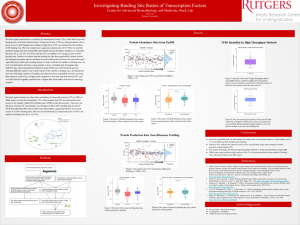Li, Zeyue: Investigating Binding Site Ratios of Transcription Factors

Title: Investigating Binding Site Ratios of Transcription Factors
Name: Zeyue Li
Major: Biological Sciences
School affiliation: School of Environmental and Biological Sciences
Programs: Aresty Summer Science Program
Other contributors: Ann Stock, Rong Gao
Abstract: Bacterial signal transduction is controlled by transcription factors (TFs), which bind to specific binding sites on bacterial chromosomes. Expression levels of TFs are often presumed to be in great excess to their binding sites, leading to high ratios of TF concentrations to the numbers of TF binding sites. Previous studies have suggested a median ratio of 10. Here we used the updated binding data from regulonDB and multiple protein abundance databases to reexamine the ratios for E. coli TFs. We discovered that TFs are unlikely to be in great excess to their binding sites. Further, we believe that the binding site data from regulonDB is biased toward the intergenic promoter regions and there are more binding sites that have not been discovered, especially those within open reading frames. To better estimate the number of binding sites, we took a bioinformatics direction, using multiple sources, including high-throughput data, gSELEX data, and computational predictions using FIMO scan of the bacterial genome. Although different sources vary in their reports of the number of binding sites, all indicated at least two fold higher numbers of binding sites than those from regulonDB. Overall, we found that repressors tend to have a higher ratio compared to activators and dual function TFs, and we found that the originally reported ratio is higher than what studies with newer technology suggests.